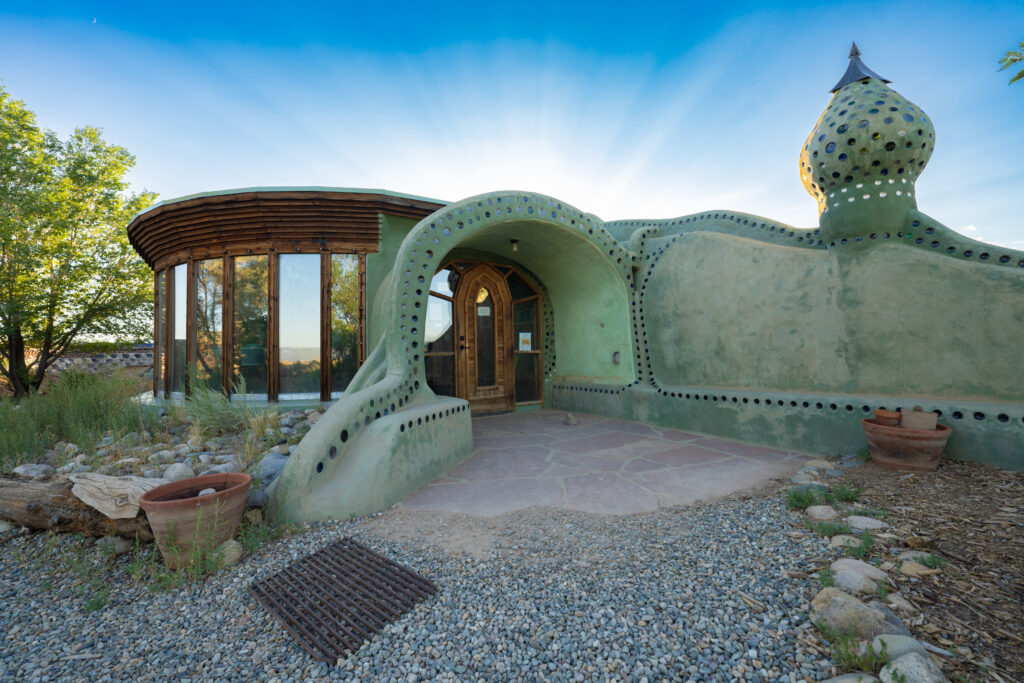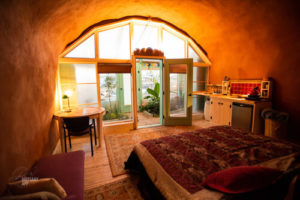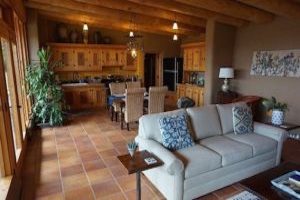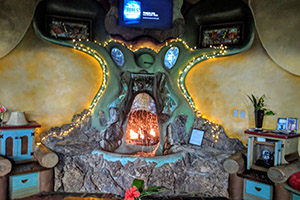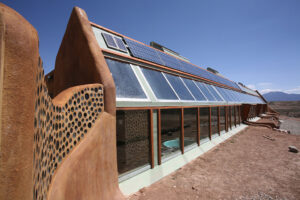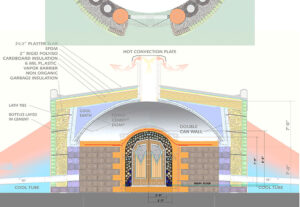I was first introduced to Earthships in 2015.
At the time I remember thinking they looked a bit like spaceships but didn’t give them much thought otherwise. Fast forward to 2018. I had recently closed my solar water heating business and was focused on a new business auctioning used goods. The new business was running fairly smoothly, but something was missing. Often would talk about moving on, but months would pass, and then years, and the day would never come. Then one day, when visiting family in Peru, my cousin asked me: “If you could do anything in the world, what would you do?” Without hesitation I replied, “I’d build an Earthship and live a sustainable life.” “So, what’s stopping you?” He asked. It was the final push I needed.
Upon returning to Canada, I contacted nearby Earthship owners to try to visit one in person. The owners were kind enough to chat at length over the phone, but explained they were no longer hosting visitors at their Earthship. They suggested I look into the Earthship Academy in Taos and try back later. After a bit more reading on the Earthship website, I learned I could travel to Taos to learn in the classroom or build one from start to finish on an International build. I wasn’t sure where to begin so I picked up the phone and called ES headquarters. A staff member informed me of a unique building opportunity coming up in Uruguay that would consist of Academy classes in the mornings and building in the afternoons. I was fortunate in the sense that I had no significant barriers (financial or otherwise) preventing me from going, so I made the necessary arrangements to hand over my business and off I went.
My time in Uruguay went better than I could have expected. I became friends with people from all over the world, learned a ton about Earthship construction, and made memories that are sure to last a lifetime. By the end of the month, I felt like my family had increased in size by 45. Many of us still keep in touch online to this day. There were so many activities happening simultaneously during the build though, that it would have been impossible to learn everything about building an Earthship in one go. The next step in graduating from the Academy was naturally to participate in a second build (or Field Study). When I learned of an upcoming build happening in Australia – somewhere I’d always wanted to go – I eagerly signed up for round two.
Just as in Uruguay, my time in Australia exceeded all expectations. Despite slicing my arm on metal lathe and requiring seven stitches on day two, I had the time of my life. On the last day, as my newfound family began parting ways something interesting happened. I was fetching screws in the shed when it dawned on me it would all be over again soon. A wave of emotion washed over me. I stood there immobilized and watched as tears rolled down my face. An Earthship build was a beautiful experience, and I didn’t want it to end. I remember thinking it was quite the revelation for me at the time. I felt I had finally found my true calling. If I was reacting this way to the project ending, it must be the work I’m meant to be doing.
After the Field Study in Australia was over, I had improved some of my construction skills (mostly carpentry), but still felt very unsure about building my own Earthship. Yes, I’d had a great month living and building with awesome people in a beautiful location, but what would happen when the magic and excitement of the Academy faded away? What would it really be like to live in an Earthship? How do I even begin the process? There were still so many questions I had around building an Earthships and didn’t know where I could find the answers.
The third and final step toward graduating from the Academy was to conduct an Independent Study. I figured this was a perfect opportunity to answer some of these looming questions. If someone with my advanced building experience still wasn’t fully sold on the concept, surely there must be information missing, and surely there must be others who feel daunted by the undertaking. Perhaps if I approached those who had built Earthships and learned from their experiences, maybe I (as well as others) might feel more confident taking on a build. Alternatively, if I learn it’s not all it’s cracked up to be, at least I’d know before getting in deeper.
I began by writing out all the important questions I had around building and living in Earthships. My belief was that any feedback (taken with a grain of salt) could be used as a learning opportunity. Readers should know that despite having participated in two builds, I had no vested interest in biasing survey results one way or the other. If the buildings weren’t working, I wanted to know before investing considerably more time and money into the process. For this reason, I made sure to request feedback around positive and negative experiences. In fact, it’s likely I gave more focus toward uncovering negative experiences as I wanted to leave no stone unturned. Once the survey was ready, I published it on my website and shared it through social media. Within a few weeks, I had responses from the following locations.
Locations of current survey respondents
After the first few weeks, responses dropped off to nil. In interest of completing the project in a timely manner, I compiled the data gathered and left the survey open to future expansion. If Earthship staff are interested in growing results, the survey can be shared with anyone via the following link: www.ianwatson.me/earthship-survey. Below is a summary of all survey results collected as of December 14th, 2020. I would be happy to update this document at a later date when more data has been gathered.
PART I: Living in an Earthship
The first section of the online survey attempts to answer all the questions I had about the living experience in an Earthship. I’ll start with a disclaimer. I did not ask the default question: is it safe to live in a house built with tires? Anyone who has researched this topic will learn that the conditions in an Earthship do not allow for tire off-gassing. I encourage anyone interested in this topic to read the report: “Use of Scrap Tires in Civil and Environmental Construction” May 10, 19951 In it, the author concludes that based on data available, the effect a tire-wall has on the living space is negligible. Tires must come into contact with high temperatures, sunlight, or solvents in order to decompose, none of which can happen while they are sealed in a wall. The use of tires was not a genuine concern for me, but I figured it was worthy of noting as it’s often the first thing people ask when introduced to the concept.
QUESTION: Is the temperature in your living space comfortable year-round?

The next logical question people often ask is are Earthships actually comfortable? This question was of particular importance to me as I have interest in building an Earthship in Canada, a particularly cold country. Fortunately for me, four of the initial respondents were also located in Canada, and one in nearby Ohio that shares similar weather conditions. Of the ten survey responses gathered thus far, four answered ‘Yes’ the living space was comfortable, five answered ‘Yes’ it was comfortable with a caveat (additional heating required), and only one answered ‘No’ it was not comfortable.
Is the temperature in your living space comfortable year-round?
I dug deeper into these results by analysing the locations of each respondent in relation to their answer. Unsurprisingly, unconditional ‘Yes’ responses came mostly from moderate climates (Australia x2, Uruguay, Taos2), while those recommending additional backup heat came from more Northern climates (Alberta, Ontario, Ohio). This is where the plot thickened, as I quickly realized geographic location was not the only factor skewing the results.
If Earthships were all produced in the same factory, with the same materials, it would be easy to predict their performance in the same way we predict how a solar panel will perform in different locations. We would simply look at the insolation levels (solar radiation) at a location and multiply them against the surface area of the solar panel. After taking into account the panel’s efficiency rating (as verified by a certified body), we would have a fairly predictable energy output – assuming everything was installed correctly. The reality is though, Earthships are built in different shapes, sizes, with different materials, different components, and by people with different levels of experience. In fact, that’s kind of the whole point of an Earthship, that anyone can build one. In other words, there is no way to answer this question in a way that can accurately be applied across-the-board, as Earthships are all to some degree unique. The only thing we can decisively say from these results, is that 100% of respondents located in Northern climates (near or above the Canadian border) said backup heat was a necessity. Based on my understanding of how passive solar heating works and its limitations, I am inclined to agree with this result.
As far as I know the only person who has recorded real-world temperature data in an Earthship is Martin Freney of the Ironbark Earthship near Adelaide Australia. Martin has proven with real- world data that temperatures in his Earthship stay near a fairly comfortable 25°C (72°F) during 37°C (100°F) weather. As far as I know though, there’s no recorded data available from any cold climate Earthships as of yet, despite there being dozens of them across Northern USA and Canada. A quick online search results in opposing opinions on this topic. I’ve read articles from ‘green building experts who say Earthships don’t work in Canada3, and also watched videos from Earthship owners in Canada claiming they work just fine4. So, who do we believe?
To answer this question properly, I think the best approach is to first understand how heating in an Earthship works. An Earthship can be thought of essentially as a heat sink (or battery) that uses sunlight to charge itself. Its orientation captures solar radiation to ‘charge’ its battery during winter, and slowly releases that energy back into the living environment in the form of radiant heat. What’s important to note though, is unlike the Earthship’s cooling functions that rely on thermal mass and convection (relatively unlimited resources), its heating technology relies on sunlight, a fluctuating resource. Due to factors like cloud cover, snow cover, and one’s distance from the equator, sunlight is highly variable across different geographic locations, and at different times of the year. A solar battery simply cannot charge at the same rate when its fuel source is not available. More accurately, the degree to which the Earthship charges with heat is directly proportional to the amount of sunlight available. If poor solar conditions persist, indoor temperatures must therefore gradually normalize back towards surrounding temperatures. There is no way to get around the physics of that situation. While the thermal mass of an Earthship creates temperature stability that to some degree delays temperature changes and prevents the Earthship from dropping below ground temperature, it’s logical to conclude that if no significant solar heat is added over time the living space will eventually equalize to surrounding temperatures. In Canada, that can easily be as low 10°C (50°F).
While ground temperatures provide a buffer against harsher outdoor temperatures, it’s certainly possible that if no secondary heat source is available during periods of low sunlight, the living space could eventually reach relatively cold temperatures. I have read unverified accounts of Earthships in Canada reaching temperatures of 14°C (57°F). For comparison, a common thermostat setting is 21°C (72°F). As critics of Earthships often fail to understand though, or perhaps are purposely misquoting, this observation does not negate the Earthship’s ability to capture and retain solar heat; it is simply being realistic about one can expect from a solar battery when sunlight levels are reduced. That’s basically like saying your phone charger doesn’t work because you only plugged it in for 1 hr, instead of the 3 it needs to reach full charge.
In order answer this question definitively, someone would need to install temperature sensors in extreme climate Earthships and monitor their performance over the course of the year. Although no two Earthships are alike, real-world performance at these locations would at least give us some ballpark of what can be achieved through solar gain in Northern climates. Without this data, it’s impossible to say in any specific terms how comfortable Earthships are at these locations, all we can point to is what we understand about the physics of the situation and the word of people who are living in them. Among the people surveyed thus far, the consensus for everyone near or above the Canadian border was that backup heating is required.
QUESTION: What is your favourite thing about living in an Earthship?

Due to each participant listing off several items in response to this question, the answers have been grouped into umbrella categories and tallied for ease of analysis. Among the ten responses, there were six mentions related to the living environment, six mentions related to self- sufficiency, and three mentions related to pride of ownership.
Favourite thing about living in an Earthship
Living Environment (40%)
One of the most quoted ‘favourite things about living in an Earthship’ was the temperature stability of the building. Several respondents made statements with regards to the building being “warm in the winter and cool in the summer”. Some praised the noise-control of the building, stating how “quiet” and “cosy” it felt due to the Earth-sheltered design. Others praised the views from the large windows, and the atmosphere created by plants in the greenhouse.
Self-Sufficiency (40%)
Equally as important to Earthship owners was the feeling of “being taken care of by the building”. There were several mentions of “not having a mortgage to pay”, “not having bills”, and electricity being available independent from the grid. There was also a mention of “not feeling vulnerable to extreme weather”, which could refer to any number of the building’s resilient qualities (temperature stability, mass, providing food/water/electricity on-site).
Pride of Ownership (20%)
Finally, there were three mentions related to pride of ownership. One respondent noted the “smaller environmental footprint”, and another owner stated, “living simply with the earth”. By adapting to natural phenomena, building with recycled materials, incorporating renewable energy, and providing basic necessities on-site, the Earthship dramatically reduces the inhabitant’s ecological footprint. As a result, the building appears to invoke feelings of pride among Earthship owners who feel they are decreasing their negative impact on the planet.
QUESTION: What is your least favourite thing about living in an Earthship?

When viewing the following data, it should be noted that six of ten current survey respondents are located in climates with higher humidity levels than Taos, where Earthships originated.
Least favorite thing about living in an Earthship
Humidity (60%)
Humidity presented a common challenge in this group of survey respondents. While all owners in dry climates like California, Australia, and Taos reported no humidity issues whatsoever, owners in other regions noted humidity levels in their buildings could be high at times. This should come as no surprise considering Earthships were pioneered by Mike Reynolds in the desert region of New Mexico, and later adapted for use in other parts of the world. That being said, the global model Earthship is said to be suitable for use anywhere, which begs the question, did something go wrong with these buildings in particular, or does the global model design need to be modified for use in wet climates? Without in-depth research into each building’s design and maintenance levels, it is difficult to pinpoint exactly what caused high humidity in each home. For example, we can’t know whether someone failed to follow design recommendations and experienced problems as a result. My speculation though is that in a place like Taos cooling tubes do not present an issue simply due to low precipitation and low humidity levels throughout the year. In areas with moderate to high precipitation on the other hand, cooling tubes will draw ambient moisture into the building so long as vents are open during humid conditions. If these conditions persist over time and moisture is allowed to accumulate in the building without remediation, it will inevitably lead to mould. While this can easily be mitigated with the use of dehumidifiers, ceiling fans, or air exchangers, these results indicate that humidity control is something builders should seriously consider when building in non-desert climates.
Too Cold during Winter (20%)
The reality of cold winters presented enough of an issue for at least two individuals in this group to mention it on their “least favourite things” list. This echoes the earlier point that one should be realistic about passive solar heating performance in extreme cold climates and plan accordingly. It’s advisable to include a supplementary heat source when designing for these locations. In Ontario for example, it’s not uncommon to have a week of overcast weather in the dead of winter. If a backup heating system is not included (or sized properly), it could certainly lead to less than comfortable living spaces during these periods. Respondents in this survey used wood stoves and in-floor heating systems to boost indoor temperatures in their homes.
Amount of Work (20%)
There were two owners who referenced the amount of work involved with Earthships, albeit under different circumstances. One owner repeatedly cited the large amount of effort required to build their Earthship. From personal experience it takes 40-60 people to relatively complete an Earthship during a one-month Academy build. Tires have many benefits as a construction material (recycled waste, easy-to-use, strong, fire and seismic resistant), but it’s no secret that pounding them is a labour-intensive process. On both builds I attended the tire wall took roughly 50% of the duration of the build. If someone chooses to build an Earthship on their own, this two-week timeline could easily extend into months or years depending on the number of people allocated to the task and the size of the Earthship.
The other mention of ‘too much work’ was in reference to the work required to maintain the building, with one owner stating that sometimes they just “don’t feel like doing stuff”. Unlike a conventional home, there are certain aspects of the building that require physical input to maintain such as monitoring the water system, monitoring the power system, operating windows and maintaining the garden. Interestingly, this respondent also cited the increased work of living in an Earthship as a positive attribute in that they were forced to work in a way that had a positive impact on the planet.
QUESTION: What part of your Earthship requires the most maintenance?

Water System (50%)
The most commonly cited component requiring oversight was the Water System. For the purpose of this tally, the water system included everything from rainwater harvesting, to rainwater filtration, to grey water recycling. One owner cited it was good practice to clean the water catchment bowl of debris at the roof level on a regular basis. Another owner cited that filters in the Water Organization Module (WOM) needed changing every 6-12 months. While it’s also recommended to change filters in conventional homes in this time frame, the WOM in an Earthship generally has one or two more filters and pumps than a conventional water system.
Batteries (30%)
The next component requiring the most maintenance was the Power Organization Module (POM), specifically, the batteries used to store solar electricity. There are two main types of batteries for storing solar electricity: Lead-Acid batteries and Lithium based batteries. Lead-acid batteries tend to be less costly, with lower lifespans and higher maintenance requirements. Lithium batteries tend to be more costly, with longer lifespans and lower maintenance. One owner with lead-acid batteries mentioned having to regularly check charge levels and top-up batteries with fluid as necessary. Another owner cited having to replace their batteries after 5 years, which depending on the battery could have been its full lifespan, or its lifespan may have been cut short due to improper maintenance or storage conditions.
Garden (10%)
Garden tasks such as planting, trimming, and harvesting will be necessary to the degree which the selected plants require. Plant upkeep varies greatly between different plant species.
Earthen Floors (10%)
A unique issue that came up in this survey was Adobe or Earthen floors damaged by AirBNB guests. While Adobe is a great natural building solution for walls, a builder may want to reconsider this material for use in floors or high-traffic areas of their building.
PART II: Building an Earthship
QUESTION: Excluding land, what was the total cost of your Earthship?

Of the Earthships surveyed thus far, only five provided information on building cost. The average between these buildings was $182,000 USD excluding land. These buildings did however vary in size and location, factors that greatly affect cost. The lowest cost Earthship was a simple survival (1 bedroom) in Australia at $120,000 USD and the most expensive was a 4- bedroom Earthship in California at $250,000 USD.
Total Building Cost in USD (excluding land)
QUESTION: How was your Earthship built?

The most common building method cited was DIY (Do-it-Yourself) at 50%, followed closely by the Earthship Academy at 40%. Only one owner noted contractors as the primary source of labour. It is common however for builders to use a mixed approach. Although contractors were only cited as the primary source of labour by one builder, they were used to some degree by 30% of the builders surveyed.
Construction Method Used
QUESTION: How long was your Earthship build?
There was an even split between short-, medium- and long-term builds in the survey group, likely due to different building methods being used. As noted above, workshop-based builds with Earthship Academy can take as little as 6 weeks, while building alone can take up to 5 years or more.
How long did it take to build your Earthship?

QUESTION: What is the capacity of your water cistern?
Of the people surveyed thus far, eight provided information on the capacity of their water storage system. Capacity varied greatly between these buildings with the smallest measuring 1,000 Litres (250 Gallons) and the largest measuring 38,000 Litres (10,000 Gallons). It’s not entirely useful to calculate an average in this situation as cistern sizing is affected by variables like local precipitation, space, financing, and the owner’s level of risk aversion. While it’s hard to make a case against having too much storage, cistern sizing should be based on a sensible calculation between annual precipitation and expected water consumption at one’s location. It should be noted that the smallest cistern in this group is an outlier, as it was the only building with access to a dug well as its primary source of water, with storage as a backup only.
Capacity of Water Storage
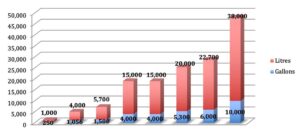
QUESTION: Is your Earthship tied to the electrical grid?
Of the buildings surveyed thus far, 50% of owners said their building was tied to the electrical grid. Some owners mentioned it was a requirement in order to qualify for a building permit, others had it available as a backup, and one indicated it was a temporary measure until they could afford a solar electricity system.
QUESTION: What was your biggest challenge during the build?
Acquiring materials
One owner said they had trouble finding enough bottles, cardboard, and tires. The owner stated ironically: “There’s so much garbage and I can’t get it.”
Feeding 35 people
One of the trade-offs of building Academy-style is there can be 30-60 mouths to feed on the job site every day. Although the Academy only requires providing one meal per day, preparing food for 30-60 people is very time consuming. The owner who opted to prepare meals themself noted it was their biggest challenge during the build. At both builds I attended the builders employed two to three people dedicated solely to this task
Keeping toilets clean
Naturally, if building Academy-style with 30-60 people on-site, washrooms will require daily maintenance in order to keep clean. The owner who opted to do clean washrooms themselves noted it was their biggest challenge during the build.
Contractor Error
One owner who hired a contractor found out their trusses had been installed backwards. They also mentioned they found out “way later”, meaning the roof was likely built over at that point. Some advice to take away from this might be to A) hire a contractor experienced with Earthship construction, or B) if you are Project Managing a build, make sure plans are always on-site and that they are being checked on a regular basis.
Waterproofing Curved Surfaces
One owner who used Hempcrete for cement arches stated it was tricky to waterproof. Another noted that the curved roofs in their design caused issues when installing flashing. This may be an argument for simpler building designs, or just to acknowledge that more work will be required to finish any funky curved details.
Tire Wall
One of the DIY builders mentioned on several occasions that they underestimated the amount of physical labour it would take to build their tire wall. They listed “the will to keep going” as their main challenge. Building a tire-wall is never really light work, but many hands can keep it from becoming soul-crushing. In my experience, with a loudspeaker and some good tunes it can even become a fun part of the process.
Finances
Without going into specific detail one owner mentioned financing was their greatest challenge. Some good advice may be to make sure one has more than enough financing available to complete the building on time. For this reason, construction budgets typically include a 10-15% buffer or ‘contingency budget’ for unexpected costs that might otherwise delay construction.
Weather:
One owner in Canada mentioned weather was a major challenge during their build. While this is a factor that to some extent is outside of the builder’s control, one can mitigate against it by scheduling construction during favourable times of the year. My guess would be that this builder who was on a DIY schedule experienced periods of rain or snowfall before their building was fully sealed and/or was forced to halt construction over winter.
QUESTION: Have any components of your building failed or not performed as expected?
Due to the experimental nature of these buildings, I was curious as to what components of the buildings (if any) did not work as well as planned.
Have any components in your building failed?

Surprisingly there was no component that failed consistently across the group. As we can see above, 40% of builders surveyed mentioned no significant failures. The remaining responses were spread between the grey water system, windows, solar system and cooling tubes.
One owner said their grey water system failed entirely and had to be removed, while another noted switching to activated charcoal filters and airing the area out helped reduce odour to manageable levels. This raises the question, did the first system fail due to improper design, improper use, or the user’s unwillingness to adapt to the system’s limitations?
The next two complaints were around the solar electricity system. As mentioned above, one owner was not happy about having to replace batteries within the first five years. While I suspect this was due to improper maintenance, it’s possible the batteries were simply low- quality to begin with. Another owner mentioned their solar system did not produce enough electricity for their needs. Sizing a solar system is a fairly straightforward process taught in the Earthship Academy. Each appliance is rated to consume a set amount of electricity which can be multiplied by the total time it’s expected to be in use. Improper sizing is therefore not so much a component failure but a rather a human failure in the design process.
One owner mentioned they got a great deal on windows with openers at the top. These windows were not meant to be installed on a 60° angle though, and as a result the owner experienced condensation dripping back into their building. Interestingly, this owner resolved the problem by designing aluminium trim to redirect condensing water into their garden bed automatically. This is a great example of the permaculture approach: creatively using and responding to change. While this is not a normal result when proper building design is followed, it’s worthy of noting as a warning to future builders planning to place windows on an angle. It’s also another example of a recurring theme that is appearing; building an Earthship often requires adapting to change.
Finally, there was one owner who experienced a collapse in a cooling tube located directly beneath their water storage tank. A solution here would be to A) reinforce cooling tubes if one is planning to place them directly beneath a storage tank, or B) simply place the cooling tubes elsewhere so they are not subject to the immense weight of the water tank.
QUESTION: How would you describe your experience getting building permits?
Fifty percent of survey respondents stated no major problem getting permits, with one even describing the process as “uneventful”. The other 50% stated it was time consuming or expensive, taking up to two years and costing $25,000-30,000 USD. This great discrepancy could be in part because requirements vary from one county to another. It could also be based on differences in each individual’s approach or their expectations around the process.
In Earthship circles, the consensus is that it’s easier to build in a county where an Earthship has already been established; That option may not always be available though. The best advice I’ve heard is to approach one’s local building department in advance to gauge their openness towards the idea. During this process, it’s advisable to ask what is required to obtain a permit and provide only that which is explicitly stated. Once a building is complete with listed requirements at time of inspection, the onus on updating those requirements falls on the building department as opposed to the builder.
QUESTION: Did you experience any unexpected costs during your build?
“The amount of dirt for the berm, and machine hours to move it.”
Builders should keep in mind that burying the length of their building in four feet of earth requires a large amount of soil that (if not available on-site) may need to be purchased. This particular owner built a very large Earthship on a level site that required several truckloads of dirt being shipped in from nearby quarries.
“Building Code made us install 3 small propane wall fireplaces as a ‘main’ heat source. In nine years have never used them. Waste of time and money. Also got rid of our composting toilet after 1 year. Just didn’t work as great as advertised in a high humid area. Went to a regular toilet with a holding tank. Have to get it pumped out every 5 years, but a $3,000 installed tank is a lot cheaper than a $15-$20,000 septic system.” Sometimes building codes have a mandatory requirement for a conventional heat source when building in a cold climate. While this owner in Canada claimed they have never used their propane heater, some counties will not grant a building permit unless conditions like this are met. Failing to comply with local building codes could subject a builder to hefty fines, removal from the premises, or even forced demolition. An example of this can be found in the Reach community outside of Taos that was sanctioned by local government for not having adequate access for emergency services. This example stresses the importance of confirming local requirements when one is still in the planning phase. At this early stage, a builder may still have the option of choosing to build in one county over another. They will also know what to plan for financially if additional requirements will be necessary to meet code.
“Living rurally the road/driveway costs were HUGE.”
Generally, the further one is from a city centre, the more relaxed building requirements tend to be. The Holy Grail of building locations are ‘unorganized townships’ that have no requirements but tend to be in very remote locations. The flip side of choosing a remote location is that building too remotely can have its associated increased costs. Apart from having to build a road, one should consider the cost of getting materials to a location if it’s particularly difficult to access (like a mountain or an island).
PART III: Advice to Future Builders
QUESTION: Did you employ any creative money or time saving strategies?
“Did most of the work myself, lived with family for the first two years of construction”
One of the benefits of the Earthship design is that it’s a low-tech building solution; meaning almost anyone can learn the skills to build one themselves. Also, because it makes use of recycled materials (tires, bottles, cans), it’s possible to source a lot of the materials for free.
“Running workshops saved time and money.”
Example: A build I participated in cost $200,000 USD and Academy tuition was $2,000 USD x 50 students. This means the builder had access to $100,000 USD to put towards their build. While some of this budget would have gone toward costs of running the Academy, the builder was likely left with a surplus from tuition. Even if the builder spent $75K on Academy costs (hiring ES Staff, providing food, bathrooms), that would still leave $25K to put against building costs. Not to mention, the builder did not pay out-of-pocket for labour that would have been required anyway, and the building was completed much faster than it would have been otherwise.
“Buy good batteries”
One owner noted they purchased more expensive batteries that were rated for 25 years if treated properly. They said: “the cheaper ones are 2/3’s the cost, but last about 8 to 10 years. Meaning more waste and more money in the long run.” As noted above, lithium batteries require less maintenance than lead-acid batteries, meaning one is less likely to have to replace them should they forget to monitor them. Even in the best case-scenario when lead-acid batteries are maintained, the 25% upfront savings amount to a 33% premium when we consider that a second set is needed to achieve a similar lifespan.
“Bought solar panels on Kijiji”
One owner said they bought 230-watt panels at $0.50 cents per kilowatt-hour, or $115 per panel. The condition of a solar panel can be tested for power output to determine its condition, meaning there is little risk in buying them used. This is just one area where creative sourcing can reduce building costs significantly. Windows also seem to be a common component purchased used or at a discount.
“Preparation”
One owner suggested trying to “buy all the materials together, and to get everything on time.” Building suppliers usually offer discounts when purchasing items in bulk, meaning one will spend less on the same amount of product bought over multiple transactions. Suppliers also offer refunds on unused supplies, whereas the time spent driving back and forth to the store cannot be regained. Worse yet, if materials are exhausted while labour is on-site, valuable productive time can be lost while workers are waiting on supplies to arrive.
This owner also advised to “be sure you can finish the building in a normal time frame” to avoid causing damage to the building if construction is delayed. A problem sometimes experienced during builds is time or money running out before the building is complete. The longer the building is unsealed, the more likely it will be damaged by inclement weather. Once water gets into an unsealed building, it can take a long time to air out or cause permanent damage. It may be helpful to have large tarps on-site, particularly in particularly rainy areas, or during periods of extended delays in construction.
QUESTION: If you were to start your build over again, what would you do differently?
The builder with condensation issues in their windows said they would change the windows to straight vertical glass on cedar with aluminium trim, rather than angled windows that open.
The builder who said their Earthship was cold said they would install in-floor heating and hook up to the grid immediately due to lack of adequate sunlight in winter.
Two DIY builders with 3-bedroom Earthships said they would build smaller. The builder with the 4-bedroom also said they would build smaller. The builder with the 1-bedroom Earthship said they would build bigger, and since they are in Australia, more bushfire-resistant with a green roof. My advice would be to take an honest look at what one really needs before building.
Two builders in Canada said they would use fewer windows but didn’t mention why. A logical reason may be that windows contribute significantly to heat loss during winter. One owner suggested re-locating vents on the roof. My guess would be that heavy snow loads may prevent them from operating.
One owner suggested they would use plant-based insulation in order to be more eco-friendly.
One owner who built their Earthship as an educational resource would have changed their design to be more aesthetically pleasing, rather than having unsightly system components exposed for demonstration purposes.
One owner whose cooling tubes collapsed stated they would not place the cisterns above the tubes, and perhaps use plastic or metal cooling tubes instead of cement. This is likely due to cement being porous and more prone to mould than the alternatives. They also said they would move their bathroom from the greenhouse into the inner comfort zone of the building, presumably because it is too hot or cold in there at some points in the year.
QUESTION: Are there any things you wish you had known in advance before building?
One owner in Alberta wished they had known how cold their building could get during winter. One owner would have liked to have more construction skills before starting their own build. One owner would have liked to know how much dirt would be required for their build. One of the DIY builders wished they had known how much effort would be required to complete their build. Another DIY builder wished they had known how much fun they were going to have, and just how well the building works.
QUESTION: Do you have any additional advice for future builders?
“Do your research!! Look at where you are building and plan for that area. Cookie-cutter designs don’t and can’t all work the same in different environments. Don’t be afraid to change things up for that. Hot, humid summers, long cold wet/dry winters, makes a huge difference in what you should build and what systems you should install.”
“Get some kind of nod of approval from the building official at the top of the promotional hierarchy at the county first before paying Engineer for plans.”
“If you can build where electric hook-up is available, I don’t see why you wouldn’t want to use it. I can use A/C appliances and my bill is like $25/month.”
“I personally did the academy and 4 complete Earthship builds before I started my project.”
“If you plan to build alone, I would build the global model and carefully budget your costs so you are sure you can finish the building”
“Do not go too cheap on the build. “ “Go for it!”
CONCLUSION
It should be noted that this survey currently has a small sample size of ten people and findings may not be representative of Earthships worldwide. Aside from these Earthships representing specific geographic locations, we should remember that no two Earthships are exactly alike, and it may not always be useful to make generalizations as each observation needs to be put in context of a specific circumstance. I would be interested in seeing how these results changed in the future, as greater numbers of survey responses would increase the validity of each trend as its incidence rate increases. Based on the results gathered thus far though, there are some key trends appearing that I would like to highlight.
While 90% of people surveyed said their living space was comfortable, 50% were located in or near Canada and indicated it was only comfortable with backup heat available. Based on these results, I would strongly recommend a supplementary heat source to anyone building in extreme cold climates; not because Earthships don’t work, but because solar heat may not always be consistent, or available in large enough quantities to combat extreme temperatures. The further one is from the equator, the less sunlight (and heat) is available in their Earthship during winter. I do not consider this a failure for Earthships, but something we need to be realistic and upfront about, as at least one owner seemed disillusioned upon learning this reality. In my opinion, it would be unwise to rely on sunlight as the only heat source at these extreme locations. It would also be unwise to presume that the same building designs that work well in Taos will work equally well in Alaska, or the Peruvian rainforest. Every time someone builds in a new location, they will encounter different conditions and as a result may have to adapt their building accordingly. Another example of this can be seen in the fact that 60% of respondents experienced high humidity levels. This was the highest correlation in the whole survey; not something that can easily be ignored. While I suspect a great deal of humidity can be managed with simple solutions, my guess is humidity was something original Earthship builders simply never had to consider when they designed cooling tubes in the desert. Based on these findings, I would certainly reconsider using cooling tubes in wet areas, or at the very least include humidity mitigation devices in my building design.
At an average cost of $182,000 USD per building, it’s interesting that the cost to build an Earthship is comparable to that of a conventional home. Over the life of the building, an Earthship should also have a much lower operating cost due to savings in heating, cooling, water, and electricity supply. This likely makes it considerably cheaper to own in the long run than a conventional home. The Earthship also has the less tangible benefit of a reduced environmental impact; something not calculated when building a conventional home. Not only does an Earthship reduce dependence on systems generally powered by fossil fuels, it captures thousands of pounds of ‘garbage’ in the process. That garbage would likely to be buried otherwise, further contaminating the Earth’s ecosystem. As found in the survey, these fuel savings come with a trade-off in the form of additional labour. A large part of this labour comes during the building process (especially the tire wall), with what seems to be a marginal amount for operation of the building (changing filters, monitoring batteries, managing airflow). While it’s certainly possible to build an Earthship alone, based on the greater amount of negative feedback, longer duration, and higher levels of issues experienced by DIY builders, I would strongly recommend building via the Earthship Academy. At the very least, I would advise consulting with an Earthship expert before putting any shovels into the ground. It’s also recommended to consult the local building at an early stage to learn about restrictions or adjustments that may be necessary in order to obtain a building permit.
Conducting this survey did confirm some issues I suspected associated with Earthships. Building an Earthship will likely take more planning, labour, and problem-solving than building a conventional home. I think one of the key issues being demonstrated in these results is that homeowners will likely face different challenges than they would face building a conventional home. They will also however experience different benefits, such as a reduced ecological footprint, pride of ownership, and a self-sustaining building. To some, this may be considered a fair trade-off.
If this survey has proven one thing, it’s that the Earthship is by no means a perfect vehicle. What I would argue is more important though, is that it tries to tackle problems that really matter, like waste, sustainability and human survival. Personally, I’d rather be on an experimental vehicle travelling down the right path, than be on one that’s proven, but travelling down the wrong one. It’s no longer up for debate that we’re headed into a future where overpopulation, industrial agriculture and climate change threaten the very infrastructure of society. In this future, a person in Earthship-style home will undoubtedly be in a better position to handle potential challenges like extreme weather, reduced water/food supply, or increased fuel costs. It’s both alarming and sad that at this point in history sustainable housing is still considered a radical concept. Bearing all that in mind, I see no better use of my time than to contribute to the improvement and proliferation of sustainable housing solutions. In a not-too-distant future – or whatever may be left of it – perhaps Earthship-inspired homes will be the ideal that housing strives toward, rather than the exception to the rule limited to the dreamers and pioneers.
When it comes to my decision to want to build an Earthship, I’ve realized it’s not just a practical decision, but a lifestyle decision. It may involve more work, or simply, different work than a conventional home, but what’s more important to me is I’ll be living in line with my values: building community, living sustainably, and setting a positive example in the world. If one simply does not value these things, perhaps the increased complexity of an Earthship may not be for them. Buying a conventional home is undoubtedly easier and may be better suited for other people’s lifestyle. In the end it comes down to what the individual values and how that translates into their decision-making process around housing. If one has the freedom and ability to afford building one, my opinion remains that the world can only be better for it.

